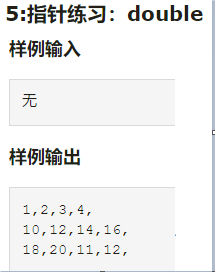c++ code:(4)pointer
/*
下面程序片段的输出结果是 Hello
*/
#include <iostream>
using namespace std;
int main() {
char s[] = "Hello";
char * p;
for( p = s; p[0]; ++p )
cout << * p ;
return 0;
}*****************************************************************************************************************************

/*知识点是函数指针*/
#include <iostream>
using namespace std;
void ForEach(void * a, int width, int num,void (*f)(void *))
{
for (int i = 0; i < num; ++i)
f((char*)a + width*i);
}
void PrintSquare(void * p)
{
int * q = (int*)p; // 类型强转
int n = *q;
cout << n * n << ",";
}
void PrintChar(void * p) {
char * q = (char*)p;
cout << *q << ",";
}
int main()
{
int a[5] = { 1,2,3,4,5 };
char s[] = "hello!";
ForEach(a, sizeof(int), 5, PrintSquare);
cout << endl;
ForEach(s, sizeof(char), 6, PrintChar);
return 0;
}&&&&&&&&&&&&&&&&&&&&&&&&&&&&&&&&&&&&&&&&&&&&&&&&&&&&&&&&&&&&&&&&&&&&&&&&&

#include <iostream>
using namespace std;
void Memcpy(char * src, char * dest, int n)
{
for (int j = 0; j <=n; j++)
dest[j] = src[j];
}
int Strlen(char * s)
{
int i;
for (i = 0; s[i]; ++i);
return i;
}
int main()
{
freopen("f:\\freopen.txt", "r", stdin);
int a;
char s1[30];
char s2[30];
int t;
cin >> t;
for (int i = 0; i < t; ++i) {
cin >> a;
int b = 99999999;
Memcpy((char*)&a, (char *)&b, sizeof(int));
cout << b << endl;
}
for (int i = 0; i < t; ++i) {
cin >> s1;
Memcpy(s1, s2, Strlen(s1) + 1);
cout << s2 << endl;
}
return 0;
}/*
Memcpy practice
输入样例:
10
15 25 35 45 55 65 75 85 95 105
输出样例:
15,25,35,45,55,65,75,85,95,105,
1,2,3,4,5,1,2,3,4,5,
123434567
167896789
*/
#include <iostream>
using namespace std;
void Memcpy( void * src, void * dest, int size)
{
//your code starts here
char * csrc = (char * ) src;
char * cdest = (char * ) dest;
if( src == dest )
return;
if( cdest > csrc && cdest < csrc + size) {
//从后往前拷贝
for(int i = size-1; i >= 0; -- i)
cdest[i] = csrc[i];
}
else {
//从前往后拷贝
for(int i = 0;i < size; ++i)
cdest[i] = csrc[i];
}
//your code ends here
}
void Print(int * p,int size)
{
for(int i = 0;i < size; ++i)
cout << p[i] << ",";
cout << endl;
}
int main()
{
int a[10];
int n;
cin >> n;
for(int i = 0;i < n; ++i)
cin >> a[i];
int b[10] = {0};
Memcpy(a,b,sizeof(a));
Print(b,n);
int c[10] = {1,2,3,4,5,6,7,8,9,10};
Memcpy(c,c+5,5*sizeof(int)); //将c的前一半拷贝到后一半
Print(c,10);
char s[10] = "123456789";
Memcpy(s+2,s+4,5); //将s[2]开始的5个字符拷贝到s[4]开始的地方
cout << s << endl;
char s1[10] = "123456789";
Memcpy(s1+5,s1+1,4); //将s1[5]开始的4个字符拷贝到s1[1]开始的地方
cout << s1 << endl;
return 0;
}
()()()()()()()()()()()()()()()()()()()()()()()

#include <iostream>
using namespace std;
void Double(int * p, int n)
{
for (int i = 0; i < n; ++i)
p[i] *= 2;
}
int main()
{
int a[3][4] = { { 1,2,3,4 },{ 5,6,7,8 },
{ 9,10,11,12 } };
Double(&(a[1][0]),8);
for (int i = 0; i < 3; ++i) {
for (int j = 0; j < 4; ++j)
cout << a[i][j] << ",";
cout << endl;
}
return 0;
}
/*
编写一个 MyMax函数,可以用来求任何数组中的最大值
使得程序按要求输出
输入数据
第一行是测试数据组数 t
对每组数据:
第一行是整数n (1<=n<=10)
第2行是 n个整数
第3行是n个浮点数
输出数据
对每组数据:
先输出n个整数中个位数最大的数(答案保证唯一)
再输出n个整数中最大的数
再输出n个浮点数中最大的数
输入样例:
2
5
31 20 100 7 8
30.1 100.2 2.5 9.8 48.4
2
1 2
0.1 0.2
输出样例
8
100
100.2
2
2
0.2
*/
#include <iostream>
using namespace std;
//your code starts here
void * MyMax(void * a,int width,int num,
int (*compare)(void * p1,void * p2))
{
void * result = a;
for(int i = 1;i < num; ++i) {
if( compare( result, ((char *) a ) + i * width) < 0)
result = ((char *) a ) + i * width;
}
return result;
}
//your code ends here
int Compare1(void * n1,void * n2)
{
int * p1 = (int * )n1;
int * p2 = (int * )n2;
return ((*p1)%10) - ((*p2)%10);
}
int Compare2(void * n1,void * n2)
{
int * p1 = (int * )n1;
int * p2 = (int * )n2;
return *p1 - *p2;
}
#define eps 1e-6
int Compare3(void * n1,void * n2)
{
float * p1 = (float * )n1;
float * p2 = (float * )n2;
if( * p1 - * p2 > eps)
return 1;
else if(* p2 - * p1 > eps)
return -1;
else
return 0;
}
int main()
{
int t;
int a[10];
float d[10];
cin >> t;
while(t--) {
int n;
cin >> n;
for(int i = 0;i < n; ++i)
cin >> a[i];
for(int i = 0;i < n; ++i)
cin >> d[i];
int * p = (int *) MyMax(a,sizeof(int),n,Compare1);
cout << * p << endl;
p = (int *) MyMax(a,sizeof(int),n,Compare2);
cout << * p << endl;
float * pd = (float * )MyMax(d,sizeof(float),n,Compare3);
cout << * pd << endl;
}
return 0;
}
//指向指针的指针
#include <iostream>
using namespace std;
int main()
{
int x, y, z;
x = 10;
y = 20;
z = 30;
int * a[3] = { &x, &y,&z };
for ( int ** p=&a[0];p < a + 3; ++p)
cout << *(*p) << endl;
return 0;
}
/*
填写内存交换函数 SwapMemory,使得程序输出结果是:
10,20,30,40,50,
1,2,3,4,5,
abcde
12345
*/
#include <iostream>
using namespace std;
void SwapMemory(void * m1,void * m2, int size)
{
//your code starts here
char * p1 = (char *)m1;
char * p2 = (char *)m2;
for(int i = 0;i < size; ++i) {
char tmp = p1[i];
p1[i] = p2[i];
p2[i] = tmp;
}
//your code ends here
}
void PrintIntArray(int * a,int n)
{
for(int i = 0;i < n; ++i)
cout << a[i] << ",";
cout << endl;
}
int main()
{
int a[5] = {1,2,3,4,5};
int b[5] = {10,20,30,40,50};
SwapMemory(a,b,5 * sizeof(int));
PrintIntArray(a,5);
PrintIntArray(b,5);
char s1[] = "12345";
char s2[] = "abcde";
SwapMemory(s1,s2,5);
cout << s1 << endl;
cout << s2 << endl;
return 0;
}
